Stage
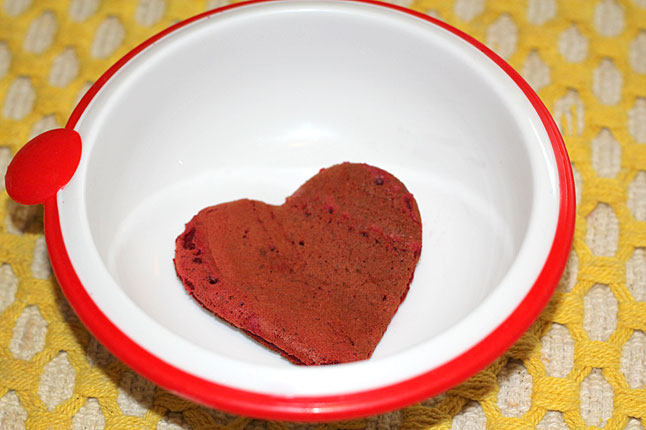
Beets act as a natural food coloring that brighten up any pancake recipe. This fun breakfast recipe is packed with nutrition! Beets are loaded with calcium, potassium and vitamins A and C. These nutritional benefits help to boost your baby’s immune system, while promoting muscle skeletal, nervous system, and brain development. In addition, beets are also high in fiber, making them easy to digest. Most pediatricians recommend introducing beets into your baby’s diet between eight and 10 months. For an overview of essential vitamins and minerals your child needs, check out our Nutrient Chart.
This recipe serves 6.
Here is what you will need to make this recipe:

- 1 cup flour
- 3/4 cup whole wheat flour
- 3 tbsp light brown sugar
- 1 tbsp baking powder
- 2 whole beets, roasted and pureed
- 1 1/4 cup nonfat milk
- 1/3 cup nonfat plain greek yogurt
- 1 whole egg
- 2 tbsp unsalted butter, melted
- 1 tsp vanilla extract









Stir the ingredients together and remember lumps are good when it comes to pancakes, the batter will not be completely smooth.

Grease the pan and pour some of the pancake mix into the hot pan or skillet, about 3 minutes each side.

Serve immediately with bananas, berry puree or any other favorite pancake topper.
If you have extra, you can store them in the freezer for up to three months.
Stage

The combination of sweet potatoes, black beans and spices makes this recipe easy-to-make and tasty. Try preparing this simple and flavorful recipe as a side dish for any meal. Sweet potatoes are loaded with vitamins and nutrients. They contain vitamins A and E, beta carotene, potassium, calcium and fiber. They are also easy on your little one’s stomach and digestive tract. Try pairing with Turkey & Gravy or Apricot Glazed Chicken. For an overview of essential vitamins and minerals your child needs, check out our Nutrient Chart.
Depending on the toddler and adult size portions, this recipe will serve approximately 6.
Here is what you will need to make this recipe:

- 1 1/2 lbs sweet potatoes, peeled
- 3/4 cup black beans, drained and rinsed
- 1/2 tsp garlic salt
- 1/4 tsp pepper
- 1/2 tsp onion powder
- 1/4 tsp cinnamon
- 1/4 tsp nutmeg
- 1/8 tsp cumin
- Cooking spray

Peel and quarter sweet potatoes.

Steam or boil sweet potatoes until barely tender, approximately 15 minutes. Let cool. Preheat oven to 400°F while the sweet potatoes cool.

Mix potatoes and rinsed black beans using an immersion blender. Blend until smooth.
Note* Add water if the mixture is dry.

Add garlic salt, pepper, onion powder, nutmeg, curry, cumin and cinnamon. Mix well.

Spray sheet pans with cooking spray. Using a tablespoon, portion out scoops of mixture and roll slightly, place 1 inch apart on prepared sheet pans.
Note* I used a small cookie scoop to keep the sizes consistent. If you would like these to turn our crispy, make your scoops smaller.

Bake in oven for approximately 10-12 minutes, until starting to brown. Then flip and bake for approximately 5 minutes or until the both sides start to brown.

Serve warm as a side dish or snack. Store in an airtight container in the refrigerator for up to three days. Reheat before serving.
Stage
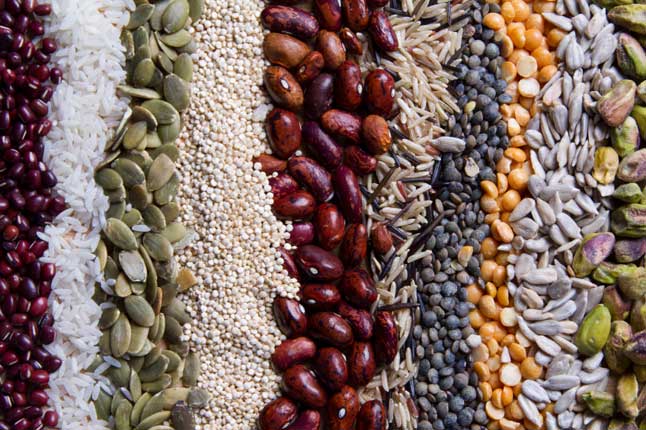
If your child refuses to eat meats, don’t worry you are not alone! Many toddlers may refuse to eat meats for a number of reasons. Either they are exerting their control over foods or maybe they just don’t like the texture. Either way, as a concerned parent it can be very frustrating since you know that protein is an important nutrient in their diet and essential for growth.
A little bit about protein…
There are basically two types of proteins
- Complete proteins – These proteins come from animal products and include: fish poultry, beef, pork, dairy foods, eggs, etc. These proteins contain all the amino acids that your body needs to build new proteins.
- Incomplete proteins – These proteins come from fruits, vegetables, nuts and grains. Although these are healthy proteins they lack one or more of the essential amino acids. However when combined together in different ways you can create a meal that does contain all amino acids (which creates a complete protein mix)
Beans and legumes
This includes peas, beans, lentils and peanuts.
Whole grains
Sometimes when I mention whole grains as a great source of protein, people are very surprised. Whole grains are usually a great source of protein and other important nutrients such as iron. Amaranth, barley, buckwheat, flaxseed, millet, oats, quinoa, rye, sorghum, spelt, wheat are all examples of whole grains.
Protein: The Breakdown
Here is a list of foods with their protein content. I love this list as it helps me to pick new foods for my son that are rich in proteins. Additional nutrient information.
| Food | Amount of protein | Other great nutrients (these foods contain more that just these nutrients mentioned) |
| Greek yogurt | 8g per 1/2 cup | Calcium |
| Black beans | 8g per ½ cup cooked | Iron, calcium, fiber |
| Peanut butter | 8g per 2 tablespoons | Manganese |
| Almonds | 8g per ¼ cup | Calcium, vitamin E, magnesium |
| Peanuts | 9g per ¼ cup | Iron, copper, manganese |
| Pumpkin seeds | 8g per ¼ cup | Magnesium, zinc |
| Soy beans | 14g per ½ cooked | |
| Amaranth | 7g per ¼ cup uncooked | Calcium, iron and zinc |
| Barley | 5.75g per ¼ uncooked | Soluble fiber, iron and niacin |
| Buckwheat | 5.75g per ¼ cup uncooked | Calcium, magnesium, B vitamins and iron. |
| Flaxseed | 7.75g per ¼ cup uncooked | Omega 3-fatty acids, fiber |
| Millet | 5.5 g per ¼ cup uncooked | Iron and Magnesium |
| Oats | 6.5g per ¼ cup uncooked | Fiber, B vitamins, iron |
| Quinoa | 5.5g per ¼ cup uncooked | Highest quality of protein—more than any other grain |
| Brown rice | 3.75g per ¼ cup uncooked | Iron, niacin |
| Rye | 6.25g per ¼ cup uncooked | Fiber, vitamin E, calcium |
| Spelt | 6g per ¼ cup uncooked | B vitamins and fiber |
| Wheat | 7.5g per ¼ cup uncooked | Fiber, iron, B vitamins |
Protein packed recipe ideas:
- Apricot Wild Rice
- Cheesy Spinach Quinoa
- No-Bake Apricot Bites
- Pear Mini-Muffins
- Pumpkin Banana Brekkie Bars
- Black Bean and Portabella Sliders
What is your child’s favorite non-meat source of protein? ***ENTER TO WIN*** Leave a comment below and you will be entered for a chance to Designed to Nourish™ WIN Puree & Simple™ Immersion Blender & Snack-A-Pillar™ Stackable Snack and Dipping cups! TEN winners will be randomly selected from all comments (U.S. residents only). Check back on Tuesday, November 13th when we will post the winners!
What is your child’s favorite non-meat source of protein? ***GIVEAWAY IS NOW CLOSED*** Leave a comment below and you will be entered for a chance to Designed to Nourish™ WIN Puree & Simple™ Immersion Blender & Snack-A-Pillar™ Stackable Snack and Dipping cups! TEN winners will be randomly selected from all comments (U.S. residents only). Check back on Tuesday, November 13th when we will post the winners!
Here are the WINNERS: Lisa J., Jessica N., Marybel R., Dana M., Lindsay S., Alicia, Michelle, Lisa, Amy and Tanya W. If you are one of the winners, you will be contacted by e-mail. Thanks to everyone for commenting!
****
Lisa Johnson says:
November 1, 2012 at 10:40 pm
We love eggs, beans and greek yogurt!!
****
Jessica Nunez says:
November 1, 2012 at 10:48 pm
My little guys loves garbanzos and black bean soup, as well as almonds and peanuts!
****
Marybel R. says:
November 1, 2012 at 10:45 pm
My twins love beans & broccoli
****
Dana McGowen says:
November 2, 2012 at 12:06 am
Brown rice and peanut butter are two of our favorites!
****
Lindsay Swab says:
November 1, 2012 at 11:23 pm
My little man LOVES his peanut butter with whole grain waffles.
****
Alicia says:
November 2, 2012 at 12:41 am
Frozen greek yogurt as a treat.
****
Michelle says:
November 2, 2012 at 12:53 am
My son loves yogurt!
****
Lisa says:
November 2, 2012 at 1:22 am
My 2yo son loves beans and yogurt. My 4yo son is loving the pb&j.
****
Amy says:
November 2, 2012 at 3:22 am
My daughter enjoys yogurt,cheese,and goat’s milk…
****
Tanya White says:
November 12, 2012 at 5:19 pm
My childrens favorite source of protein is peanut butter
****
Stage 5
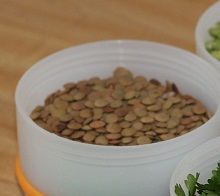
This simple toddler friendly recipe combines lentils, veggies and rice in a delicious way.
- 3 tbsp lentils
- 2 tbsp brown rice
- 1 clove garlic, diced
- 1 tbsp tomato paste
- 1 cup water or chicken stock
- 1 tbsp olive oil
- 1/4 cup carrot, onion and celery mix
- 1 Bay leaf
In a small pot on medium heat, bring oil to temperature and add carrot, onion and celery mix, sauté for 3-5 minutes, add garlic sauté for 2 minutes more, stir in tomato paste. Add remaining ingredients and bring to a boil, reduce heat to a simmer cover with lid for 25 minutes. Check tenderness of rice and lentils, stir if needed add more water or stock. Cool slightly and let your little explorer enjoy!
Recipe Yields: 3 Servings
Storage Time: 3 months in the freezer
Stage 5

Serve this delicious and nutritious lentil dip with pita bread. Cut pita into triangles and cut fresh veggies such as carrots, tomatoes, cucumbers and celery to serve along with the dip
- 1/2 cup dried lentils
- 1/2 cup split peas
- 1 tbsp olive oil
- 1/2 cup chopped red onion
- 1 tbsp chopped garlic
- 1 tsp cumin
- 1/2 cup cilantro leaves
- 2 tbsp fresh lemon juice
- 1/4 cup whipped cream cheese
- 1 tbsp paprika
Cook lentils and split peas in large pot of boiling water or stock until very tender, about 35 minutes. Drain and set aside. Heat 1 tbsp olive oil in heavy large pan over medium heat. Add onion and garlic and sauté until onion is translucent, about 5 minutes. Add cumin and stir 1 minute. Transfer mixture to blender or food processor. Add lentils and split peas, cilantro, lemon juice, paprika and 3 tablespoons water. Process until smooth. If the mixture is dry, add water until desired consistency. Season to taste with salt and pepper. Transfer to medium bowl and stir in whipped cream cheese. Can be prepared 1 day ahead. Cover and refrigerate. Bring to room temperature before serving. Serve with pita bread a fresh cut veggies.
Recipe Yields: 10 Servings
Store in an air tight container in the refrigerator.
Storage Time: 5 days in the refrigerator
This recipe is an excellent source of fiber. Serve this with fresh veggies for an extra nutritious snack.
Stage 3
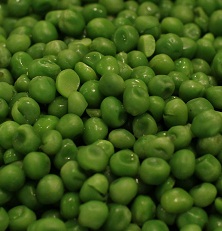
- 10 oz package of frozen peas
- 4 cup vegetable stock or chicken stock
- 1 whole clove of garlic, minced
- 1 whole carrot, chopped
- 1/2 cup onion, chopped
- 1 roma tomato, chopped
- 1 small parsnip, chopped
- 1 tsp rosemary
- 1 tsp butter or olive oil
- Salt and pepper to taste
Rough chop all vegetables, sauté in a small stock pot with butter or olive oil and season with salt, pepper and rosemary. Add 3 cups stock or water, bring to boil add peas and reduce heat to a simmer for 8-10 minutes. Remove from heat and cool slightly before blending to desire consistency, for a smoother puree add the remaining cup of stock.
Serve hot or cold and share this fun dish with your toddler along with the rhyme:
“Pease porridge hot, pease porridge cold, pease porridge in the pot 9 days old. Some like it hot, some like it cold, some like it in a pot 9 days old.”
Recipe Yields: 4 Servings
Storage Time: 5 days in the refrigerator
This recipe is a great source of vegetables and is rich in vitamins and nutrients. In addition, green peas are rich in antioxidants and offer anti-inflammatory benefits.
Stage

I am a fan of potato pancakes, and after reading this recipe, I was excited to try them with broccoli. The ingredients in this recipe are an excellent source of fiber and help to aid in digestion. This recipe is also a wonderful source of vitamin C, vitamin K, potassium, iron and offers other nutrients that are necessary for your child’s growth and development. Another benefit to adding broccoli — combining a familiar food like potatoes with broccoli increases the likelihood for acceptance. For an overview of essential vitamins and minerals your child needs, check out our Nutrient Chart.
Depending on the size of your broccoli potato pancakes, this recipe will make 10-15 pancakes.
Here is what you will need to make this recipe:

3 potatoes, medium-large
1 tablespoon olive oil
1/2 cup onion, chopped
3 cloves of garlic, minced
1 egg
1 crown of broccoli, chopped
1/3 cup chickpeas
1 teaspoon baking powder
salt and pepper to taste

Rinse chickpeas and grind in the food processor until they become a powdery consistency. Set the chickpeas aside to add later.

Peel potatoes and chop.
Note * There isn’t a science to the size you need to chop the potatoes. I cut them so they would fit better in the the food processor.

Chop broccoli.
Note* The broccoli will also be ground in the food processor, so the size you chop the broccoli isn’t important.

Chop onion.
Note* You will add the onion to the food processor also, so chop coarsely.

Grind the broccoli in the food processor until the texture is fine and add to a large bowl.

Grind the potato and onion in the food processor. When you remove the potato and onion from the food processor, pat with paper towel to remove the moisture, then add to the broccoli.

Mince garlic and add to the mixture.

Add the egg to the mixture and stir.

Add chickpeas and baking powder along with a pinch of salt and pepper to the mixture and mix until completely combined.

Coat pan with olive oil.

Drop the mixture onto the olive oil coated pan in the size of 1 inch balls. Using a spatula or you hand, flatten them into the pan. Bake at 425 for 15 minutes.

Remove the pancakes from the oven after 15 minutes and flip. Bake for another 10 minutes until they are crunchy and brown.

Serve the broccoli potato pancakes warm. One pancake is a serving for a toddler, and two for an adult. These pancakes can be stored in the refrigerator for later, just reheat before serving.
Try serving with Apricot Glazed Chicken or Creamy Chicken and Asparagus.
Stage 5
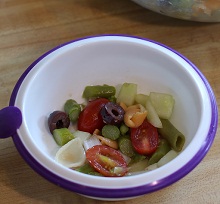
This recipe is packed with veggies, flavor and bright colors.
- 1/3 cup pasta, any fun shape your child likes
- 1 cup asparagus, chopped
- 18 grape tomatoes, cut in half
- 1/8 cup red onion, diced
- 1- 5oz mozzarella ball cut into cubes or 1/3 cup small mozzarella balls
- ½ cucumber peeled, seeded and cut into small chucks
- 4 black olives, sliced
- 1 tbsp honey
- 3 tbsp extra virgin olive oil
- 1 tbsp soy sauce
- 1 tbsp red wine vinegar
- salt and pepper to taste
Cook pasta according to box, during the last 5 of pasta boiling add asparagus to boil. Drain and rinse with cold water. While the pasta and asparagus is cooking, whisk together all dressing ingredients. Place all of the salad ingredients in large bowl and toss together with teh dressing.
Recipe Yields: 4-6 Servings
Serve immediately or chill and serve later.
Storage Time: 3 days in the refrigerator
This pasta salad recipe contains valuable vitamins and nutrients. One of the main ingredients in this recipe is asparagus. Asparagus provides antioxidant nutrients, including vitamin C, vitamin E, beta-carotene and several minerals including zinc and manganese. In addition, asparagus is a heart healthy vegetable that rich in fiber and aids in digestive support.
Stage

These brownies are a perfect sweet treat and a great alternative to other high sugar and high calorie brownie recipes.
When I first read this recipe, I have to admit, I was a little skeptical of the words “black beans” and “brownies” being in the same sentence. After making them, I was pleasantly surprised in how chocolaty and delicious they turned out to be. These brownies are great for special occasions. They are a nice alternative to a traditional cake and other super-sweet, sugar-shocking desserts. The black beans add bulk and fiber to this recipe, and the applesauce makes the brownies moist. For more information on all of the nutrients your baby needs, check out our nutrient chart.
Here is what you need to make your own batch of black bean brownies:

- 3/4 cup cooked or canned black beans
- 1/4 cup olive oil (or canola oil)
- 1/2 cup applesauce
- 2 eggs
- 1/4 cup unsweetened cocoa powder
- 1/2 cup sugar
- 1 teaspoon vanilla extract
- 1/4 cup mini chocolate chips
- 1/3 cup flour
- 1/2 teaspoon baking powder
- 1/2 teaspoon salt
- 1/8 cup confectioners sugar, for dusting (optional)

Combine black beans, oil and applesauce.
Note* If you use canned black beans, be sure to drain them.

Using the immersion blender, purée the beans, oil and applesauce.

Next add the eggs and cocoa powder.

Add the vanilla and sugar.

Melt half of the chocolate chips and blend them in with the mixture using the immersion blender.

In a small bowl mix together the flour, baking powder and salt.
Note* I used wheat flour, but white flour is fine.

Using the immersion blender, mix the flour mixture in with the batter until smooth.

You can stir in the remaining mini chocolate chips to the batter if you would like.
Note* For a healthier option, skip the folded in mini chocolate chips. It will still be tasty and sweet!

Bake at 350 degrees Fahrenheit in a greased 9×9 inch square baking pan. Pour into prepared pan and bake 25-30 minutes.

When done, the surface will look matte or dry, the very center may still look shiny. Let cool at least 15 minutes and add powdered sugar (optional) before cutting and removing from pan.

You can cut them into squares or use a cookie cutter for a fun design.
Stage

Pumpkins: Not just for jack-o’-lanterns anymore!
While pumpkins naturally attract more attention during Halloween season than any other time of year, this surprisingly nutritious fruit (yes, it really is a fruit!) can be a healthy addition to your baby’s diet. Packed with Vitamin A and beta-carotene, pumpkins are also a good source of potassium, protein, and iron. These beneficial nutrients are known to promote bone growth and muscle development while helping to combat diseases. Pumpkins are also low in fat but high in fiber, which helps the digestive process, and makes them perfect for almost any baby food recipe!
Nutritious ideas for your little pumpkin.
Most pediatricians suggest that your infant be at least six months old before beginning to safely eat pumpkins. You may want to introduce your baby to pumpkin in pureed form. Also, consider boiling, steaming, or baking pumpkins and mixing them into homemade cereals and yogurts, and even with meats, such as chicken or turkey. To help to ensure love at first bite, many moms swear by adding a small bit of butter and cinnamon to the pumpkin mix for a tasteful treat your little one won’t be able to resist. When buying pumpkins, you will find that smaller, immature varieties work best in your baby food dishes. Look for cooking pumpkins, sugar pumpkins, or pie pumpkins for a flavorful addition to your baby’s diet.
Did you know?
Pumpkins are a member of the gourd (Cucurbitacae) family, which also includes squash, cucumbers, gherkins, and melons. Made up of 90% water, pumpkins are grown on every continent except Antarctica. Most historians agree that the jack-o’-lantern tradition was started by the Irish, who carved ghoulish faces on turnips and placed candles within them to celebrate this scary holiday. When Irish immigrants migrated to America during the Irish Potato Famine in the mid-1800s, they discovered that pumpkins were more plentiful than turnips, plus were larger and easier to carve.
Try this at home.
If you are interested in going beyond the can in your cooking, here are several ways to prepare your pumpkin.
Bake it. To do this, simply cut the pumpkin in half and remove the stem, seeds and stringy pulp. Place the two halves face down in a shallow baking dish and cover with foil. Bake for approximately an hour to an hour and a half (until tender) in a 375 degree oven. Once it has cooled, scoop and puree the flesh.
Steam it. Prepare the pumpkin just like you would for baking. You can then steam it on the stovetop. Just place a steaming basket in the bottom of a pot large enough for both halves. Add water to the pot and bring to a boil, making sure to add enough that it will not boil dry in 20 minutes. Add your pumpkin, cover and steam for 8 to 12 minutes. Pumpkin is also easily steamed in the microwave. Either method will take about the same amount of time.
Easy pumpkin recipes for the whole family:











